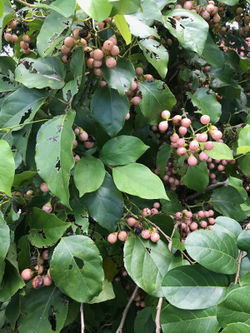Clammy Cherry
From Wikiwel
Other Names : Cordia dichotoma, Cordia indica, Cordia ixiocarpa, Cordia domestica, Cordia latifolia, Indian cherry, Fragrant manjack, goborhut, bahubara, Bahubara, Boch, लसोड़ा Lasora, Dieng mong, Naruvari, Lamkelaba, Bhokar, Shelu, Muk, Vad gundo, Doducallu, Bahuvarah, naruvili, citam, naruvali, bankanakkera, chinna-nakkeru, botgiri, बोहोरी Bohori, कालोबोहोरी Kalobohori, Anonang, Shleshmataka, Picchila, Bhuta Padapa, Dwij Kustsaka
Contents
Special Precautions of Clammy Cherry
- The fruit is a cooling, and heavy.
- Leaf extract has anti-implantation activity, and works as a natural contraceptive drug.
Properties
- Bark considered astringent and tonic.
- Fruit considered demulcent, expectorant, analgesic, anti-inflammatory, hepatoprotective, diuretic, aphrodisiac and anthelmintic.
- Studies have shown anti-ulcer, wound healing, hepatoprotective, antioxidant, anti-inflammatory, antipyretic, antimicrobial, anti-implantation,
Health Benefits and Uses of Clammy Cherry
- Lasora tree is used traditionally in the treatment of dyspepsia, fever, ringworm, ulcers, prolapsed of the uterus/vagina, headache, affection of the urinary passage, diseases of lungs, and spleen. The leaves, fruit, bark, and seeds have been reported to exhibit antidiabetic, antiulcer, anti-inflammatory, immune-modulator, and analgesic activities.
- Traditional Use : It was eaten to suppress cough and for the treatment of respiratory infections and a sore throat, as it has demulcent properties. The pulp was also applied as an emollient to mature abscesses, to calm rheumatic pain and as an anthelminthic. In Tanzania the fruit pulp is applied on ringworm. In Mali and Côte d’Ivoire the leaves were applied to wounds and ulcers. A macerate of the leaves was taken to treat trypanosomiasis, and is externally applied as a lotion to tse-tse fly bites. In the Comoros the powdered bark is applied to the skin in cases of broken bones before a plaster was applied, to improve healing. Bark powder was used externally in the treatment of skin diseases. Bark juice together with coconut oil was taken to treat colic.
- it is regarded as a useful anti-inflammatory
- help with the symptoms of high blood pressure.
- Fruits can be used as an expectorant, for coughs and for lung diseases.
- Decoction of the stem bark is taken for dyspepsia, diarrhea, dysentery fever, headache, stomach-ache, and as a tonic.
- Externally, the moistened bark is maturative when applied to boils, swellings and tumors.
- It is applied to ulcers in the mouth in the form of a gargle or as a powder.
- Teeth are rubbed with the bark to strengthen them.
- The bark is used to treat catarrh in Burma (Myanmar).
- Juice of the leaves is also considered cooling, and is applied as a poultice to treat migraine, inflammation and swellings.
- Powdered seeds or the fresh fruits are applied to skin eruptions and gonorrhea.
- Fruit is very mucilaginous and highly esteemed for coughs and diseases of the chest, the uterus and the urethra.
- In larger quantities it is given in bilious affections as a laxative.
- The fruit is considered demulcent and the bark mildly astringent and tonic in India.
- Seeds are considered a good remedy for ringworm; they are powdered, mixed with oil and applied topically.
- In India, the mucilaginous fruits are used for cough and chest complaints on account of their demulcent properties.
- Entire plant is used for snakebite, and a decoction of the fresh bark is used for fever and dyspepsia.
- In Indo-China and Africa, the fruits are eaten, and are also used as an emollient and tonic.
- Bark is a tonic and the powdered seeds are applied as a paste on skin problems.
- Ripe seeds are used as an anthelmintic to treat taenia and ascarids in Vietnam.
- In El Salvador and the West Indies, a decoction of the leaves is applied to bruises, swellings and skin diseases.
- Pressed juice of the leaves is given to cure malaria.
- Kernels are a good remedy in treatment of ringworm.
- Leaves are useful as an external application to treat ulcers and headache.
- The Javanese use the bark in treatment of fevers.
- Bark paste was used for treatment on spider bites and eruptive boils.
- Seed is considered to be beneficial in the treatment of difficult urination, fever, inflammation and various urinary disorders.
- Tea made from the leaves is used in the treatment of headaches and as a wash for burns and scalds.
- Poultice of the leaves and roots is applied to wounds.
- An infusion of the leaves and roots is used as a wash on scalds, burns and VD sores.
- Powdered seeds are applied to skin eruptions and gonorrhea.
- Decoction of the stem bark is also beneficial after parturition.
- Juice of the fruit is also useful to remove excess phlegm from the lungs and treats cough and asthma.
- Cold infusion of the bark or root is given in a dose of 40-50 ml to treat burning micturition and difficulty in micturition.
- Paste of root is applied over the area affected with skin diseases like eczema and ringworm.
- Fresh juice of the fruit is known to increase the sperm count in male.
- Decoction of the bark is consumed regularly to improve the general body strength and remove fatigue.
- Juice of the bark along with coconut’ milk relieves severe colic.
- Bark is given for dysentery together with Pomegranate rind.
- Bark is useful in calculous affections, strangury, and catarrh.
- Powdered bark is applied on itchy skin patches on hands, and legs.
